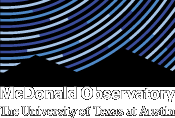Anita Cochran Named Fellow of American Astronomical Society
The American Astronomical Society (AAS), the major organization of professional astronomers in North America, has honored Dr. Anita Cochran, Assistant Director of McDonald Observatory and Senior Research Scientist, for extraordinary achievement and service by naming her an AAS Fellow for 2021.
Cochran was honored for her research addressing the molecular composition and structure of comets and her decades of service to the astronomical community.

